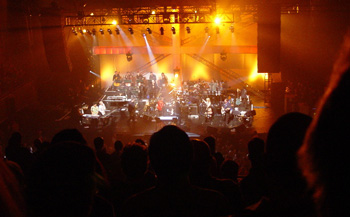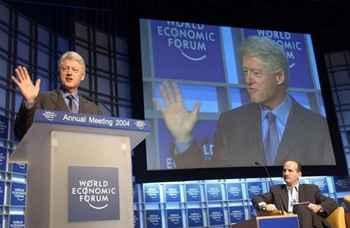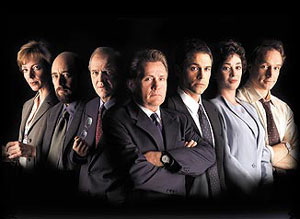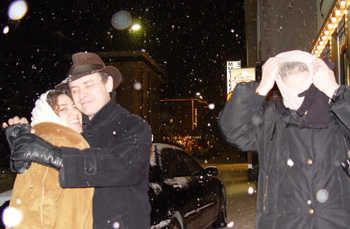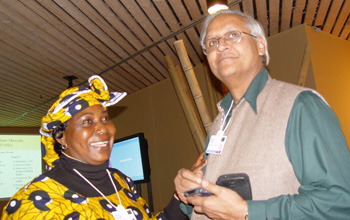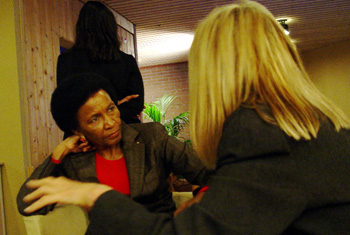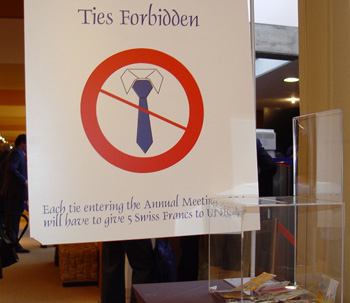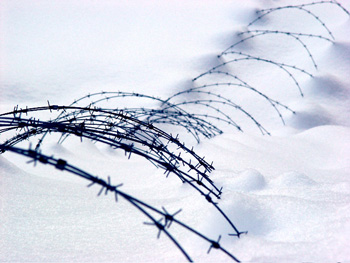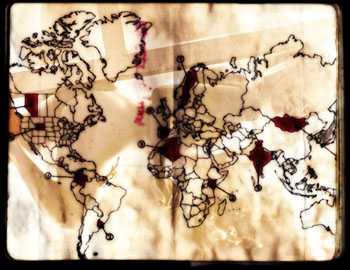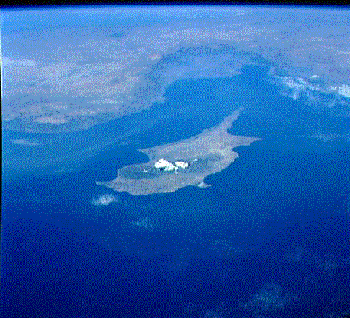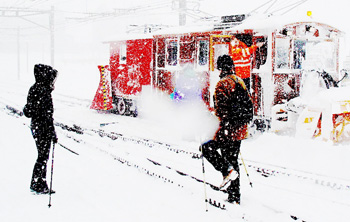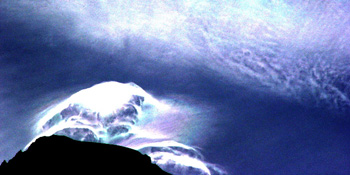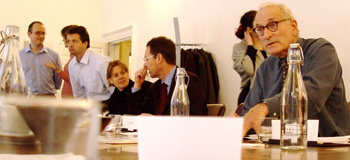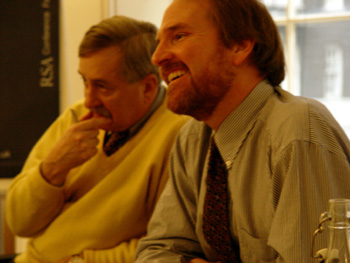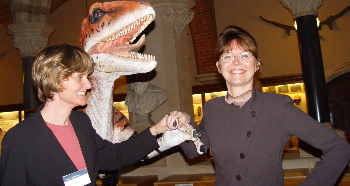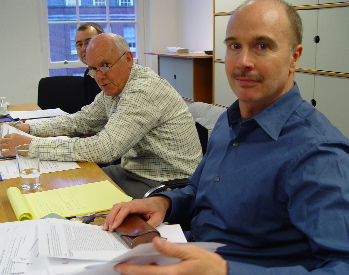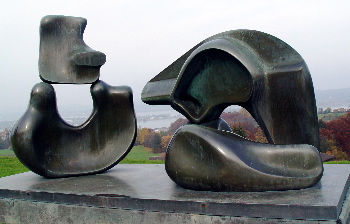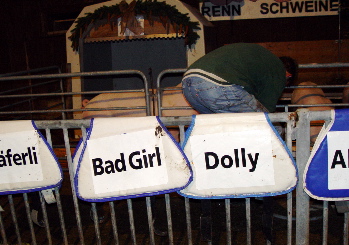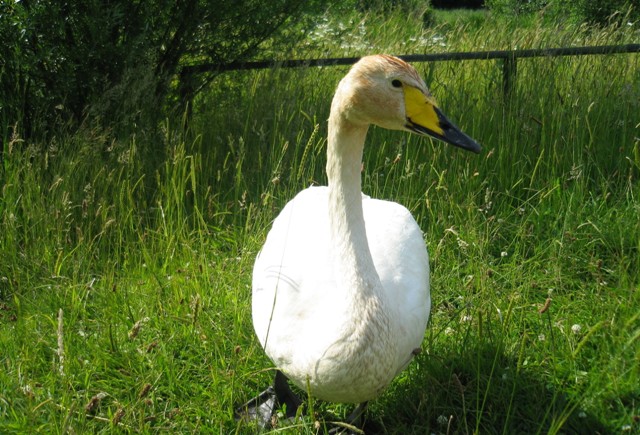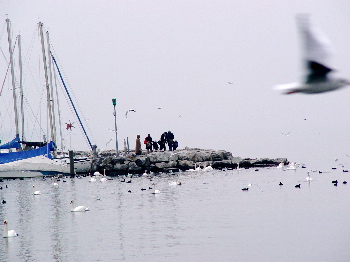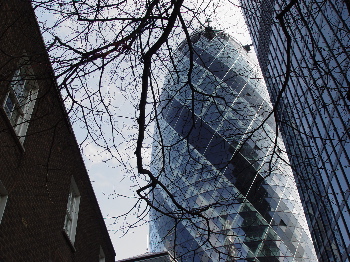Monday, March 29, 2004
London’s Living Room

City Hall (©JE)
Odd to think that Norman Foster’s City Hall will one day look dated, as my sepia portrait suggests. Chaired a debate on the top floor, The London Living Room, this afternoon on the CSR agenda for the advertising industry. Launching Opportunity Space, the report we did on the sustainability agenda for advertisers for the European Association of Communication Agencies (EACA: see www.eaca.be). Organised by Soli Townsend of FUTERRA and backed by the likes of the Institute of Public Relations, the Institute of Practitioners in Advertising, St Luke’s Communications and UNEP. Panel included Nicky Gavron (candidate for Deputy Mayor), Mike Longhurst of McCann Erickson, Peter O’Donaghue of BT and John Sauven, Greenpeace UK’s Campaigns Director.
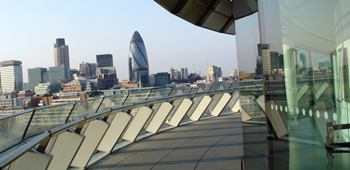
Erotic Gherkin from top of City Hall (©JE)
Afterwards, we wandered out onto the balcony, and Nicky gave a group of us a guided tour of the building – which is extraordinary. One intriguing sight: the carpet on the ground floor which shows more or less all of London. Everyone promptly went looking for their patch. I found Barnes, with Nicky’s boots straddling the Thames. Walking back by the river to Blackfriars, I was bowled over once again by how beautiful Thamesside London now is.
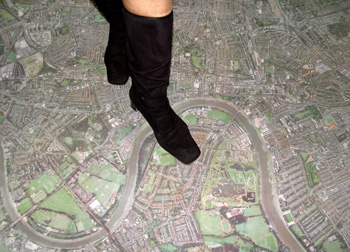
Nicky Gavron’s boots over Barnes (©JE)
Thursday, March 25, 2004
Prius Armada
Westminster Abbey’s bells were sounding an extraordinary carillon, and silver Toyota Priuses (hybrid-powered) whisking back and forth, as I emerged after a day at the ‘Business & Society’ conference organised by The Guardian and The Observer at Church House. On my way there this morning, I walked past Abbey Orchard Street, site of our first office for Environmental Data Services (ENDS) in 1978. Amazing how much has changed since then.
At the conference I was part of a panel discussing a case study put together by Roger Cowe on a high-end tropical fruit importer facing a whole raft of commercial, governance, human rights and environmental problems. Others on the panel were Alison Austin of Sainsbury’s, Chris Marsden of Amnesty and Jules Peck of WWF.
The Prius fleet was in promotion mode, silently ferrying people to various stations for their trips home. I walked, enjoying the sound of the bells.
Wednesday, March 24, 2004
Void of Memory
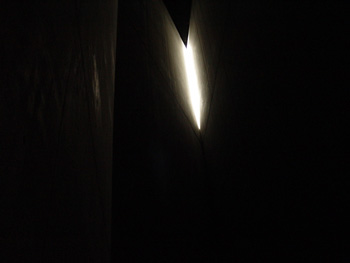
Inside the Holocaust Tower (©JE)
This afternoon, before leaving for the airport, I visited the Jewish Museum (www.jmberlin.de), designed by Daniel Libeskind. Weird that the zinc-covered building, slashed and gashed with razor-thin windows that slice through the structure at odd angles, has no obvious entrance or exit. You have to go in through the old Baroque-style Berlin Museum, then descend underground.
Libeskind has done an extraordinary job. The Axes of the Holocaust, of Exile and of Continuity are literally stunning. The exhibits of wallets and packages thrown from the transports as people were shipped off to the concentration camps connect viscerally. I stood for some time in the dark concrete entrails of the Holocaust Tower. But the most traumatic experience was the ‘Void of Memory’, where the floor was covered in layers of round face-like metal cut-outs. Like Spielberg’s girl in the red coat in Schindler’s List, the eye searches among the endless faces and figures for one that stands out. As you walk on the faces, they clink, like the points in the railways as the heavy-laden cattle wagons passed.
Outside, racing around the Garden of Exile, were a bunch of young teenagers, mindless, aggressive, the sort who when all this starts to happen again will be wearing the smart uniforms and loading the transports. As I walked past a Boss store this afternoon, I recalled that Hugo Boss designed uniforms for the SS. And a strange fact about the Jewish Museum in Prague, where I spoke at the previous VW AutoUni event: the wealth of items displayed there survived because Heinrich Himmler, head of the SS, had his men collect all the Jewish memorabilia they could find for a museum he planned to open after the war on how the Jews were exterminated.
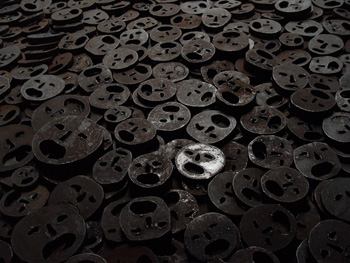
‘Fallen Leaves’ (Shalechet), by Menashe Kadishmen (©JE)
Bugati and Isle of the Dead
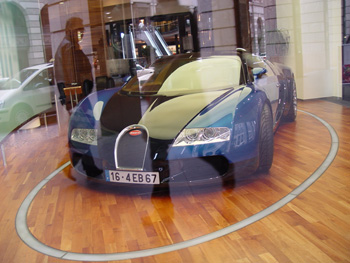
How much is that Bugati in the window? (©JE)
Did my 90-minute session with the Volkswagen AutoUni this morning. Took place in VW’s AutoMobility Forum, a veritable temple to cars. In the front windows were a Bugati and two extreme Bentleys. Spent the afternoon in museums – and found myself wondering what archaeologists in the 25th century AD would make of our fixation with cars, autobahns and the like? Are billionaires buried with their Bugatis as Pharaohs or Bronze Age chieftains were with their chariots? Perhaps it’s only a matter of time. In the Alte Nationalgalerie, I came around a corner to find Böcklin’s ‘Isle of the Dead’, one of my favourite paintings – and the first time I had seen the original.
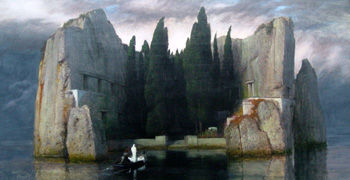
Isle of the Dead (©JE)
Tuesday, March 23, 2004
Newton’s Naked Wives

Romeo & Juliet, Berlin-style (©JE)
Berlin. Arrived at Tegel airport around 18.30 and took a taxi into the city. Had been sitting alongside a screaming baby in the plane, which I considered a form of torture, until I got talking to the taxi driver. Iranian, in Berlin for 15 years, spent seven years in an Iranian prison – out of a sentence of 10 years as a “spy” for the “Russians and Americans” (sic). Babies pale into insignificance.
A self-confessed Communist, he apparently never belonged to the Party. Made it up in his head as a teacher. His brother, who lives in the UK, basically bought him out, paying smugglers $5000 to get him across the Iranian border. We had a ‘wide-ranging discussion’, as politicians tend to say, extending from the reactions of different European societies to ethnic minorities to the philosophy of the likes of Bertrand Russell, Hegel and Spinoza. He said that Berlin has 800 Iranian taxi drivers – and 700 Iranian doctors!
On arrival at the Berlin Hilton, in the old East Berlin, I walked around the Under den Linden area. Extraordinary buildings. Hearing American accents in the streets, though, I couldn’t help but wonder what the American and British bomber pilots who flew overhead in the 1940s would have made of the city now. Strange feeling of walking on shattered glass, broken bones. Walking past the Maxim Gorki Theater, light-washed in lime green, I took some photos of their illuminated hoardings of plays they are doing or have done. An extraordinarily German version of Romeo and Juliet, and another picture of half a dozen men being hung on a gallows, but with at least two smiling. Not sure I’ll include that one – but I will drop in below the one of Frederick the Great throwing a big shadow: Magic Moment.
Bumped into Dr Stefan Wolf of Volkswagen when I got back to the hotel, together with a number of his colleagues. We repaired to the Newton bar a block or so away. I had walked past it ten minutes or so earlier, thinking Isaac. Helmut. I sat in front of a massive, wall-sized photograph of the man’s wives, all naked. But it was a nice Cabernet Sauvignon.
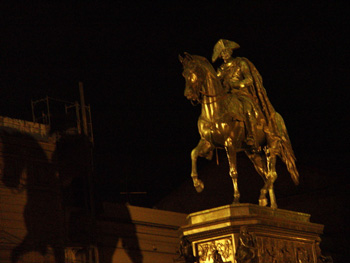
Frederick the Great’s statue on Unter den Linden (©JE)
Thursday, March 18, 2004
Wine & Cheese
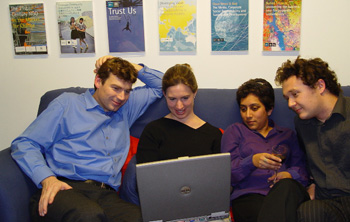
Tell Muenzing, Katie Fry Hester, Kavita Prakash-Mani, Nick Robinson (©JE)
Meetings with advertising industry, Greater London Authority and an American ‘green’ author – Karen Christensen – who we have known for years, in parallel with a major meeting in the office with half a dozen companies on the reporting agenda, followed by a celebration of our first anniversary in the Holborn office. After I took it, it struck me that the photo, taken during the celebration (which included a blind tasting of half a dozen wines and a selection of cheeses from Neal’s Yard), illustrates SustainAbility’s diversity: Tell is German, Katie American, Kavita Indian and Nick from New Zealand.
Wednesday, March 17, 2004
ECGD
Day spent working flat out on the Global Compact study, except for a trip across to Canary Wharf for a meeting of the Export Credits Guarantee Department’s advisory council, where we went through the issues surrounding the extraordinary Baku-Tbilisi-Ceyhan (BTC) oil pipeline, which runs from the Caspian to the Mediterranean.
Monday, March 15, 2004
Spanish Government Falls
Spanish election throws up a major surprise: government out, opposition under Jose Luis Rodriguez Zapatero in, promising to pull Spanish troops out of Iraq by 1 July. One reason commentators think the reverse happened is that the government had defaulted to blaming ETA, criticising those who suggested that this was 3/11, another Al-Qa’ida extravanganza.
Sunday, March 14, 2004
The Social in CSR
Evidence starts to point towards Al-Qa’ida. A new tape claims responsibility on behalf of the group and the Spanish authorities have arrested a number of people whose nationalities point away from ETA.
Today’s Observer notes that the Government will shortly publish draft regulations requiring over 1,000 top UK companies to publish their social and environmental performance. And The Sunday Times contains a Business in the Community supplement entitled ‘Companies That Count’. Subtitle: ‘Measuring, Managing and Reporting Responsible Business Practice’. My op-ed appears. The original text, which may have changed slightly in the published version, ran as follows:
Begins:
What a difference a single word can make, particularly if it happens to be social. In the wake of the Enron, Andersen and Global Crossing scandals, the US economy rocked on its heels as the Bush Administration and the New York Stock Exchange scrambled to bolt a series of stable doors after a stampeding herd of corporate horses. Under roiling political dust-clouds, the Sarbanes-Oxley Act was whipped through to rein in corporate boards and their financial auditors. And the mantra on the lips of most American politicians and business leaders was corporate responsibility (CR).
Across the Atlantic, the language and thinking seem very different. Even in the wake of the Ahold, Equitable Life and Parmalat scandals, most Europeans still prefer to use the phrase corporate social responsibility (CSR). But, while it may seem that there is an ocean of difference between these two terms, recent marketplace controversies suggest that the difference may be more apparent than real. Lets look at just three.
First, the access to medicines issue. With some four billion ill-served people worldwide, there is growing interest in how they can be provided with things like clean water, affordable energy and drugs for diseases like HIV/AIDS, tuberculosis and malaria. As a result, pharmaceutical companies like GSK, Novartis and Pfizer are under intense pressure to supply their products at or below cost to developing countries. The threat to conventional business models in the pharma sector is alarming.
Second, closer to home, we have obesity. Companies like Coca-Cola, Kraft and McDonalds have come under mounting pressure as the fat issue caught fire. Even companies likely to benefit mightily from obesity-related disease are worried. Take Denmarks highly ethical Novo Nordisk, which makes drugs for diabetes. On the face of it, obesity should be great for Novos business model, since overweight people are more likely to develop diabetes. But the longer term implications for health care systems are so dramatic that Novo has linked up with the World Health Organisation and Oxford University to find ways to slim down the problem to a manageable size by 2020.
Third, there is the geography of jobs crisis. As globalisation spurs major western companies to export jobs to places like Eastern Europe or to developing countries like Mexico, Vietnam or China, the flame of public indignation has ignited under companies like BT (with its call centres in India), Nike (with its habit of continuously shifting garment and shoe production to lower-cost countries) and Wal-Mart (accused of single-handedly hollowing out the US economy).
Whereas BT and Nike are now working energetically to engage their stakeholders on such issues, some companies will find it almost impossible to persuade the wider world that they are socially responsible. Think of Microsoft or the sheer aggression of the Wal-Mart business model, with some critics dubbing the worlds largest corporation a retail cancer. But whatever their motivations, businesses that ignore or fail to understand – hardening demands for responsibility, accountability and real sustainability risk paying a hefty price. Ask Monsanto.
Ends.
Saturday, March 13, 2004
The Great Drain Robbery
A weird globalisation story in The Times, entitled ‘Police look into Great Drain Robbery’. Apparently the effects of the economic boom in southern China can be felt in the streets of towns and cities as diverse as Gloucester, Grantham, Moldova and Shanghai. Holes are appearing in the said streets as manhole covers are stolen to feed China’s growing appetite for scrap metal. What started out as a manhole cover will probably end up being re-exported to Europe or wherever as a car, refrigerator or cooker. The problem is worst in China itself, where 1,826 covers were apparently stolen in the space of 45 days in Shanghai alone, and eight people who fell into the resulting holes drowned.
When I first came to London, I noticed that even if the streets were not paved with gold the pavements were festooned with manhole covers sporting the name ‘Elkington’. Ironically, it was shortly after I had been working in Egypt, trying to help protect some of the Nile Delta’s major wetlands, that I learned that the firm that makes the covers was started by a relative. Apparently he got his start when he rammed a metal rod one day through the puddled clay bottom of a flooded piece of land, which promptly drained. Given the appetite for productive farmland, his drainage business boomed – and the total area of wetlands shrank in lock-step.

Contribution, 1970
And the news also stirred the memory vaults, reminding me of a track by Shawn Phillips (see under Influences, ‘Other People‘), called Manhole Covered Wagon. Not my favourite song off his 1970 album Contribution, which was Withered Roses. All can be heard, thanks to the wonders of modern technology, at www.shawnphillips.com. Amazing to think that it’s now 34 years since we met him in Positano, on our way to Greece.
Baying for Shell’s Blood
Shell’s travails continue to attract much media attention. The Financial Times reports that the ousting of Sir Philip Watts hasn’t stopped the baying for blood. Other top executives, including Jeroen van der Veer, the new chairman, and Judy Boynton, the company’s chief financial officer, are also said to be vulnerable. It will be interesting to see what impact all of this will eventually have on the corporate social responsibility and sustainable development agendas, which Shell had embraced so wholeheartedly in the wake of its Brent Spar and Nigerian travails from 1995 on.
However close in you get to a company, and SustainAbility has been working with Shell since 1997, it’s impossible to know everything that’s going on. Another example of that uncomfortable fact turns up elsewhere in today’s FT, with commentary on the just-published Penrose inquiry report on Equitable Life, the pensions provider Elaine and I were with before it hit the wall.
John Chapman notes that in its heyday, which is when we joined, Equitable Life was very different from the rest of a highly exploitative industry, riddled with malpractice. In particular, he says, it was marked out by its “super efficiency, low charges, honest surrender values and avoidance of commission-hungry IFAs” [independent financial advisers]. Stupidly, we ignored the advice of our previous IFA, who warned against putting all our pension eggs in one basket.
Perhaps Equitable could have been saved if the Government had had a broader vison, Chapman suggests, being merged with the Post Office or a building society to break the hold of the current commision-hungry culture that dominates the UK pensions industry.
Milky Way

Part of The Creation of the Milky Way, 1637
Extraordinary painting in The Times Weekend Review today, showing The Creation of the Milky Way, painted in 1637 by Rubens. The immediate reason why it took my eye was that three streams of milk are shooting out from Juno’s breast past the head of a rather middle-aged looking infant Hercules, sitting on her lap. The milk curves through a dark night sky to become the star-fields of the Milky Way.
And those streams, in turn, caught my eye because of the conversation Hania and I had as we walked to the Yatra restraurant in Dover Street on Thursday evening, with Elaine and Peter Kinder of KLD. I was recalling what happened at an Oxford University Press reception at Ely House, in Dover Street, in 1977 – shortly after Gaia was born. Elaine was still breast-feeding at the time, but Gaia was at home with me. As Elaine stood talking with a man she had once worked with at OUP, she noticed to her horror that a jet of milk was arcing through her blouse and splashing off the man’s suit. She turned away before the damage was too great – or perhaps before he noticed!
As the four of us walked along, I was carrying a bag of books I had bought at Waterstone’s, including Felipe Fernadez-Armesto’s new book (incidentally published by OUP), So You Think You’re Human? An interesting question when the newspapers are awash with words and images on man’s inhumanity to man. I first met Felipe in New York at the 2002 World Economic Forum, held there in solidarity with a city rocked by the 9/11 attacks. Now today’s Guardian wonders whether the Madrid attacks represent Europe’s 9/11? Or perhaps 3/11?
But today’s Guardian also also runs a story purporting to show a far bigger disaster even than 9/11, with Manhattan being inundated by a tsunami – a still from a new film, The Day After Tomorrow, which is designed (but not necessarily destined) to make global warming an election issue this year in the US. It’s a tough sell in the US.
Had e-mail exchanges during the week with Peter Goldmark, a new member of SustainAbility’s Council who also recently joined Environmental Defense to run their climate change campaign. He has just written a play, which I’m reading, on what might happen if Osama bin Laden were to be captured. At the dinner on Thursday, someone mentioned a rumour that bin Laden had been captured nine days previously in Pakistan and was being held incommunicado. The news suggests otherwise, but who really knows? If it were true, though, it would put the Madrid bombings in a somewhat different light.
Strange times, strange rumours, strange calculations – will Madrid help or hurt the Bush re-election campaign? Whatever, we have to be optimistic that we can change American hearts and minds, but one of yesterday’s papers noted that Arnold Schwarzenegger, California’s Governor, owns no less than seven Hummers. presumably each one needs its own oilfield. Schwarzenegger, at least in his Terminator role, has the wherewithal to fight for his oil, but it’s worth asking where our appetite for fossil fuels and the gathering processes of climate change will take us.
The Guardian piece on The Day After Tomorrow mentions the Global Business Network (www.gbn.org) scenario on climate change, which got headlines recently largely because it was prepared for the Pentagon. And the Pentagon, it was reported, is increasingly alarmed by the security implications of climate change. I use a slide drawing on the GBN scenario in some of my presentations at the moment, as an indication of just how far climate change could push us in the coming century.
Friday, March 12, 2004
Madrid
Two minute silence today in the middle of my speech to MBA students at London Business School, in memory of the nearly 200 people who died and the many injured in the Madrid rail bombings.
When the news first began to come through yesterday, my reaction was that this wasn’t ETA but Al Qa’ida, partly because of the scale and partly because of the multiple, simultaneous attacks. Spain’s involvement in what Al-Qa’ida not surprisingly see as a repeat of the Crusades makes the country an obvious target. But there’s a deeper, longer history of antipathy between the Spanish and the Arabs (or ‘Moors’), who it’s easy to forget occupied much of Spain for close on 800 years.
When in Barcelona recently, I talked to people who thought the ETA threat very much under control: my reaction then was that it’s almost impossible to exitinguish such movements, but this just feels different to anything ETA have done before.
And my next thought was how vulnerable many western cities now are: three of our offices are in cities with subway-like systems: London (Tube, and probably the likeliest target), San Francisco (BART) and Washington, DC (M).
In the taxi across to LBS (I had to carry a good deal of propaganda), I chatted to the driver about his time working on the Tube, years ago. He told hair-raising stories about how drivers and other colleagues consumed Gargantuan quantities of alcohol and drugs, one taking flagons of cider with him in the cab as he drove. Once when he couldn’t drive a train, the supervisor told him to go off to the pub until a train was available. When he said he hadn’t any money, the supervisor apparently gave him £10, a lot of money in those days. When the time came to drive, he was totally, incoherently drunk and couldn’t even make it out of the pub. He said the King’s Cross disaster tightened things up a lot, with spot tests for alcohol at least.
Arguing that the Tube system was wide open to attack, and even telling me how it might be done, he then commented that at times it seemed that the Underground staff didn’t need the IRA or Al Qa’ida to cause mayhem: it was a DIY job. And as for terrorists boarding overland trains, he said they would probably be scared off by how dangerous the trains are these days!
Monday, March 08, 2004
Good Migrations
Spent the day in Den Haag. Had planned to interview Pieter Winsemius for the Global Compact study before an ING advisory board meeting, but BA flight was delayed due to de-icing at Schiphol airport. Luckily, Pieter offered to drive me back to the airport and we did the interview on the road, driving along under the leading edge of a massive storm front. He was the Dutch environment minister, then led the McKinsey environment practice. Now, among other things, he chairs the advisory board for ING’s sustainability fund.
Got back to London to find excellent article in the Financial Times on SustainAbility’s just-launched report on responsible offshoring, carried out for BT and posted on their website (www.btplc.com/societyandenvironment/index.htm). Title of Alison Maitland’s article: ‘Offshoring: How BT achieved good migrations‘.
Sunday, March 07, 2004
Jet Lag and Bondage
Lovely piece in today’s New York Times on jet lag, by Pico Iyer. I quote: “I often think that I have traveled into a deeply foreign country under jet lag, somewhere more mysterious in its way than India or Morocco. A place that no human had ever been until 40 or so years ago and yet, now, a place where more and more of us spend more and more of our lives. It’s not quite a dream state, but it’s certainly not wakefulness, and though it seems as if we’re visiting another continent, there are no maps or guidebooks to this other world. There are not even any clocks.” Somewhere that emotions run riot.
Maybe jet lag (which I always say I don’t experience) is why I enjoyed two bouts of TV last night so hugely: Status Anxiety on Channel 4, by Alain de Botton, explored the fragility of self-worth based on the opinions of others, while 1999’s 007 film The World Is Not Enough, I confess, was the most enjoyable Bondage I have seen in over 20 years.
Jet lag also features in a stunning novel I’m reading at the moment, William Gibson’s Pattern Recognition. Have always loved his books, but this one is particularly engaging. The main protagonist, a ‘coolhunter’, has just arrived in London from New York, Gibson noting that “her mortal soul is leagues behind her, being reeled in on some ghostly umbilical down the vanished wake of the plane that brought her here, hundreds of feet over the Atlantic.”
Gibson later has one of his characters, Bigend, say that our notion of the future is very different from that enjoyed by our parents, let alone our grandparents. It’s almost as if we are suffering from a cultural form of jet-lag. “For us,” Bigend says, “things can change so abruptly, so violently, so profoundly, that futures like our grandparents’ have insufficient ‘now’ to stand on. We have no future because our present is too volatile.”
For me, one form of Hell would be a world with no future, another one with no books. Trawling around the Harvard Book Store and nearby Co-op, I came back with a case-full, among them: 1968, by Mark Kurlansky (whose Cod I adored); Emotional Design, by Donald Norman (sub-title: ‘Why we love – or hate – everyday things’); In Defense of Globalization, by Jagdish Bhagwati; Our Final Hour by Britain’s Astronomer Royal Martin Rees; Truman, by David McCulloch (whose biography of a previous US President, John Adams, was given to me some years back by Peter Kinder); The Change Makers, by Maury Klein; What Ifs? of American History, edited by Robert Cowley; and Wheels for the World, a huge book on Henry Ford and his company by Douglas Brinkley.
The last of these I largely bought because of Ford’s spectacular $5 a day offer to workers, made in 1914. One of those totally counter-intuitive steps from which an entire world then spooled, which I plan to reference in the Global Compact report we are working on.
And, finally, someone else who has been experiencing culture shock has been Gaia, after her move to Wiltshire last weekend. Alone for several days in the house, she writes of the “uninterrupted silence”, except for “the cow barn opposite, which sounds like a crate-load of tetchy brachiosaurs at dawn and dusk.” She also mentions colliding with celebrity cook Jamie Oliver and family in the gardens of nearby Babington House, “goslinged by about twenty uniformed ex-unemployed youths”. Maybe it’s jet-lag again, but I find the imagery ‘pops’ like corn in my simmering brain.
Saturday, March 06, 2004
Cambridge, MA
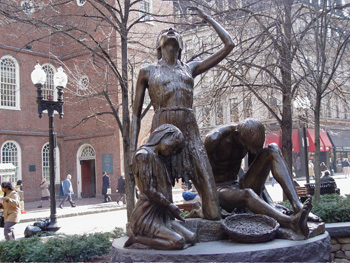
Memorial to ‘The Great Hunger’, Boston (©JE)
Arrived back this morning from Boston/Cambridge, where I have spent the past few days. Mainly there for the launch of the Corporate Social Responsibility Initiative by Harvard’s John F. Kennedy School of Government. The Faculty Chair for the CSRI is Professor John Ruggie, the Director Jane Nelson (a long-standing friend and member of SustainAbility’s Council). The project pulls together four existing KSG centres: The Center for Business and Government, The Center for Public Leadership, The Hauser Center for Nonprofit Organizations and The Joan Shorenstein Center on the Press, Politics and Public Policy. Given the nature of university politics, which tend not to favour interdisciplinary ventures, this is quite an achievement. More details from the CSRI website (www.ksg.harvard.edu/cbg/csri.htm).
On the flight across, I read The Coming Democracy: New Rules for Running the World, by Ann Florini. As I told her when I found myself sitting next to her at the CSRI launch, I took the book intending simply to skim it – and found myself absolutely gripped. A rare occasion when the adulatory blurbs on a book’s cover are more than mutual back-scratching between colleagues!
I stayed with Peter Kinder, co-founder and President of socially responsible investment firm KLD (www.kld.com). On the first evening, he suddenly said that Robert McNamara was talking at the Kennedy School, so off we went – to find an absolutely brimming-over audience in KSG’s John F. Kennedy, Jr. Forum, tier upon tier, to hear a man who both Peter and I loathed during the Vietnam War. As Secretary of Defense for Presidents John Kennedy and Lyndon Johnson, McNamara was a key architect of the Vietnam War. Even though he left government in 1967 to head the World Bank, his reputation among Baby Boomers has always been Darth Vaderish, to say the least. But he turned in a stellar performance on Wednesday evening, drawing on Errol Morris’s film The Fog of War, that has just won an Academy Award (www.errolmorris.com).
Among the things he talked about was the Cuban missile crisis, which he described as the “most dangerous moment in human history”. When he explained how far Cuba had actually got with stockpiling nuclear warheads, the case scarcely needed arguing further. President Castro, he said, admitted to McNamara himself many years later that he knew the missiles were there, that he had advised the Russians to use them, and that he knew (but accepted) the fact that much of Cuba would be wiped off the map as a result. No wonder McNamara warned the KSG students present about the deadly risks in having 7,500 strategic nuclear warheads in US hands alone, with one man’s finger potentially between us and Armageddon.
McNamara also noted that a key factor behind the US misreading of the Vietnamese situation was a total lack (at least among the US top brass) of understanding of – and empathy with – the Vietnamese themselves. He warned that the same issues are now surfacing in relations with the worlds of Islam. He asked the audience how many Arabic degrees we thought had been awarded in a recent year by all US universities. The answer: eight!
Given that I am currently reading, among many other books, Frederick Taylor’s insightful new book on the fire-bombing of Dresden on 13 February 1945, I was particularly interested in McNamara’s description of what it had been like to be involved in the B29 fire-bombings of Tokyo and other Japanese cities in WWII. The first fire-raid on Tokyo alone, he recalled, burned alive an estimated 83,000 people. If we had lost WWII, he said, he and many others would have been branded war criminals.
But perhaps the most thought-provoking point McNamara made in the entire evening, pretty much as a coda to the discussion, was that the key thing that those present could do in their later careers would be to “surface the divisive issues”. Looking at the man, and listening to the sheer power of his delivery, I have to confess I wondered how much quarter he would have given to dissidents in his heyday?
Given the family histories of people like the Kennedys and (possibly also) McNamara, my eye was even more taken than usual by the memorials around Boston and Cambridge to ‘The Great Hunger’. Even the fire-raid tolls in the US pale in comparison. Reading the plaques around the memorial outside a Borders bookshop in Boston (see above), I was reminded that one million Irish people died and two million were driven into exile. The memorial recalled the ‘Coffin Ships’ that bore them (or at least the lucky ones) across the ‘Bowl of Tears’, their name for the Atlantic. The memorial attributed the disaster to crop failures, absentee landordism, colonialism and weak political leadership. It looked forward to the day when “history finally ceases to repeat itself”.
On the basis of what I had heard about the nuclear game of ‘Chicken’ between Castro, Kruschev and Kennedy, I can’t say I left Logan airport last night confident that we would break the cycles of human history, short of removing humanity from the scene entirely. But the sheer intellectual firepower of the CSRI event gave me some hope that we might be able to make at least some progress.
On the Thursday, for example, we had a high-energy debate between Gro Harlem Brundtland (former Director-General of WHO and Prime Minister of Norway), Conference Board President and CEO Richard Cavanagh, Accenture International Chairman Vernon Ellis, Rosabeth Moss Kanter of Harvard Business School and David Gergen, Director of KSG’s Center for Public Leadership.
And before leaving for the airport, I had lunch at the Harvard Faculty Club with Paul Hodge, who directs the Harvard Generations Policy project – and is founding editor of the new Harvard Generations Policy Journal, which can be downloaded at http://www.genpolicy.com/. Jane (Nelson) had put us in touch. Although Paul’s main current concern is the financial shockwaves that will be created as the Baby Boomers get to retirement age – with the first cohort turning 60 in two years – we got into all sorts of other areas of generational policy. One of his ideas: governments, and ideally companies too, should carry out generational impact assessments before taking major decisions.
Idle thought: Where would that have left British politicians during what we prefer to call ‘The Irish Potato Famine’ in the 1840s, let alone President Castro in the 1960s?

